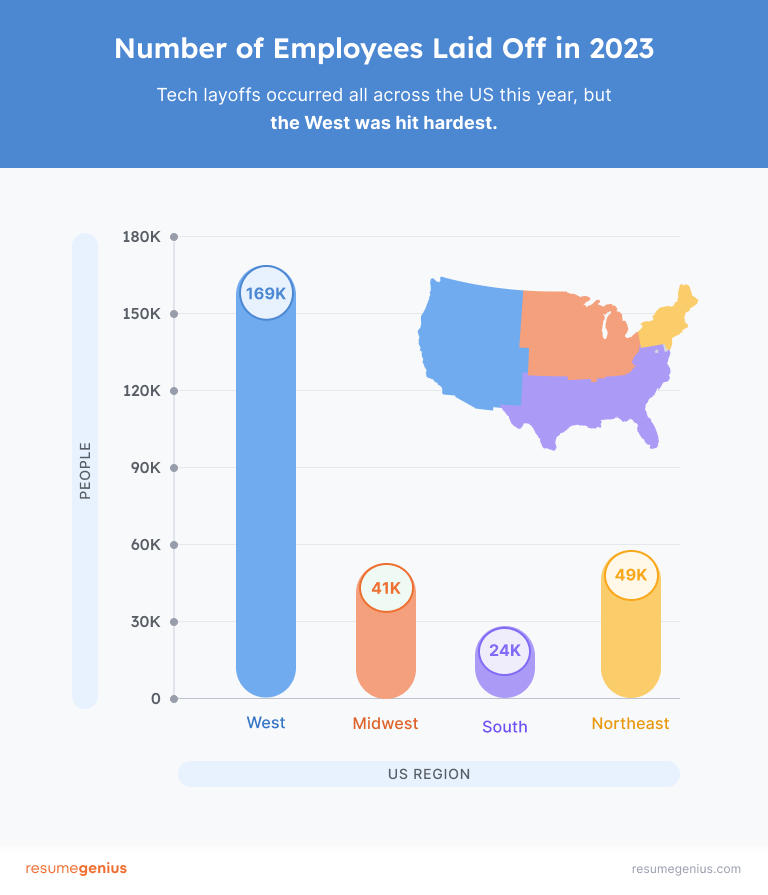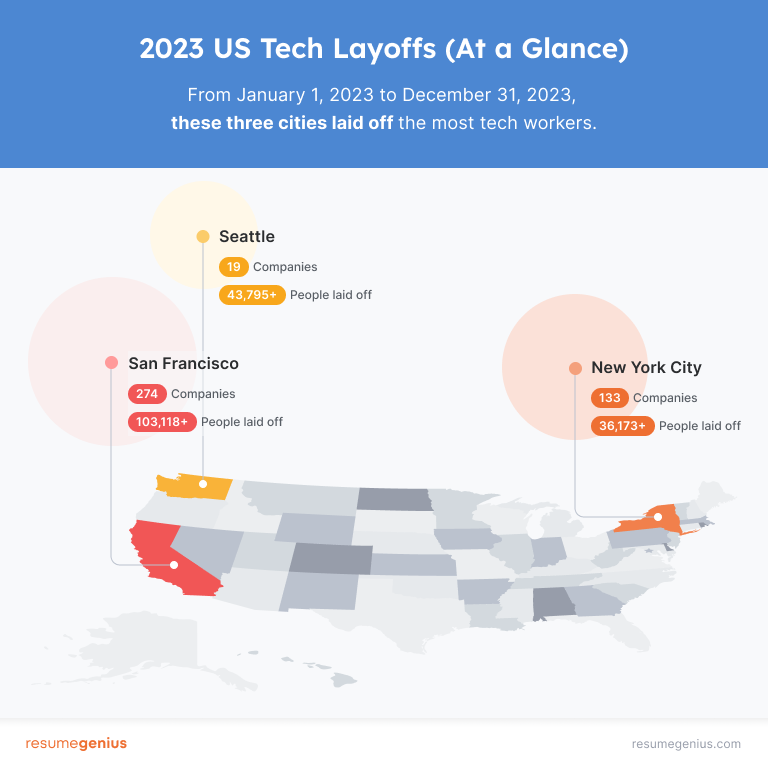Recently, the historically booming tech sector announced several hiring freezes and growth slowdowns, which in turn caused mass job cuts and waves of uncertainty.
The result? More than 285,000 employees at tech companies across 60+ US cities lost their jobs.
Using data compiled from several authoritative sources (Layoffs.fyi, Layoffs Tracker, Crunchbase, and TechCrunch), we’ve produced a heat map to highlight how many people have lost their jobs and which cities have been hit hardest by the recent layoffs.
This interactive heat map above:
- is divided into the four US regions (labeled blue for the West, orange for the Midwest, pink for the South, and purple for the Northeast)
- helps you see the number of layoffs and affected cities when hovering over each area
- lets you scroll or click the plus-minus button so you can zoom in and out of various regions
Which US cities were most affected by the layoffs?
As illustrated above, 700+ companies laid off employees in 2023. And in particular, 36.12% of layoffs were from the San Francisco Bay Area, one of the world’s most prominent tech hubs.
We’ve compiled the latest layoff numbers from December 2023 below:
December 1 to December 31, 2023 Tech Layoffs (Snapshot)
- The number of tech layoffs is at 3,626+ job cuts occurring from December 1 to December 31, 2023.
- As of December 31, 285,481+ US tech employees have been laid off from more than 700+ companies.
- The layoffs have affected 10 industries in the last month, with the highest number of job cuts happening in retail (1,064+ layoffs) and transportation (1,050 layoffs).
- The Western region of the US was the most severely affected as workers faced 3,341+ job cuts from 12 companies from December 1 to December 31.
- Cruise, a robotaxi company operating from the San Francisco Bay Area, is slashing 900 jobs from its workforce.
- Seattle-based online retailer Zulily laid off 839 employees this December and is permanently shutting down.
How many layoffs have occurred since the start of 2023?
Notably, 31.45% of all job losses occurred in January 2023.
As the tech industry prepares for further job cuts, we’ve gathered the statistics below:
| Month | Number of Layoffs |
|---|---|
| January 2023 | 89,522+ |
| February 2023 | 33,353+ |
| March 2023 | 36,953+ |
| April 2023 | 18,331+ |
| May 2023 | 35,573+ |
| June 2023 | 9,210+ |
| July 2023 | 13,010+ |
| August 2023 | 22,803+ |
| September 2023 | 9,215+ |
| October 2023 | 10,196+ |
| November 2023 | 6,355+ |
| December 2023 | 3,626+ |
Which US region faced the most layoffs in tech?
Here are other data figures related to the job cuts per region in 2023:

| Region | Companies | People Laid Off | % of Companies | % of Layoffs |
|---|---|---|---|---|
| West | 453+ | 169,866+ | 56.63% | 59.50% |
| Northeast | 180+ | 49,496+ | 22.50% | 17.34% |
| Midwest | 93+ | 41,891+ | 11.63% | 14.67% |
| South | 74+ | 24,228+ | 9.25% | 8.49% |
| Total | 800+ | 285,481+ |
Which industries have laid off the most people?
Several industries in the tech world dealt with substantial changes in 2023.
Andy Challenger, jobs expert and Senior Vice President of employment firm Challenger Gray & Christmas, states:
“For the first six, seven months of this year, we’ve seen really dramatic cuts, especially compared to the year prior where we were still in the depths of a real labor shortage. Where we’re primarily seeing the cuts in tech, health care, real estate, [and] finance, tend to be higher-paying white collar jobs.”
Below are other industry-specific statistics compiled from our data:
- The healthcare industry made up 10.5% of the job dismissals, coming in first place for the highest number of layoffs by industry
- Coming in second is the Software as a service (Saas) industry with 10.1% layoffs
- The third highest number of layoffs occurred in the finance industry, making up 9.5% of the job cuts
- The education, robotics, and social sectors were the least affected at 0.7% layoffs
Which job positions were the most affected by the tech layoffs?
Using data from LinkedIn’s Economic Graph and 365 Data Science, here’s a closer look at the impact of tech job cuts, with numbers reflecting up to June 2023:
- 27.8% worked in HR and talent sourcing
- 22.1% of software engineers were impacted
- Marketing roles followed with 7.1%
- Customer service constituted 4.6%
- PR, communications, and strategy roles accounted for 4.4%
Product managers are especially feeling the pressure
LinkedIn’s Workforce Confidence Index survey of 5,000 participants highlighted roles that felt more anxiety about potential layoffs and budget reductions, especially in relation to new product launches:
- Product managers – 46%
- Quality assurance roles – 40%
- Marketing positions – 39%
- Finance roles – 37%
- Information technology (IT) jobs – 37%
Female workers in tech are taking a hit
Marking a change from the usual male-dominated landscape, Axios reported that according to an analysis of 3,404 workers by Layoffs.fyi, women made up 45% of the laid-off employees.
High-income earners fear a loss of income
Although reports of job losses in tech and financial sectors decreased in recent months, Morning Consult’s Income Inequality Index indicates an elevated level of anticipated loss of earnings.
In August 2023, 21.2% of high-income individuals anticipate more pay losses. In contrast, only 14.5% of those with low incomes and 7.8% with middle incomes feel the same way.
A closer look at the tech giants’ job losses
Below is a breakdown of 365 Data Science’s distribution of layoffs across positions at major tech companies (Twitter, Amazon, Meta, Microsoft, Google):
Twitter (300 laid-off employees)
- Software engineering – 23.7%
- Marketing – 12.7%
- PR, communications, and strategy – 9.3%
- Customer success – 8%
- HR and talent sourcing – 4.7%
- Other – 41.7%
Amazon (257 laid-off employees)
- HR and talent sourcing – 37.4%
- Software engineering – 28.8%
- Program management – 5.8%
- Quality assurance (QA) – 3.1%
- Data science – 2.7%
- Other – 22.2%
Meta (208 laid-off employees)
- HR and talent sourcing – 29.8%
- Software engineering – 18.3%
- Marketing – 10.1%
- PR, communications, and strategy – 4.8%
- Data analysis and data science – 4.3%
- UX design – 4.3%
- Other – 28.4%
Microsoft (142 laid-off employees)
- HR and talent sourcing – 39.4%
- Software engineering – 13.4%
- Program management – 7%
- Cloud and data centers – 6.3%
- Marketing – 3.5%
- UX design – 3.5%
- Other – 26.7%
Google (102 laid-off employees)
- Software engineering – 35.3%
- Program management – 16.7%
- HR and talent sourcing – 15.7%
- Customer success – 4.9%
- Product management – 3.9%
- Marketing – 2.9%
- Sales – 2.9%
- Other -17.7%
HR and recruiting professionals faced the most layoffs — but bounced back
Since October 2022, HR specialists and recruiters bore the brunt of the ongoing layoffs, constituting 27.8% of the laid-off workforce. However, over half (52%) of this group secured new positions by March 2023.
According to 365 Data Science’s tech layoffs aftermath analysis reflecting figures up to the end of June 2023, other working groups who found employment again include:
- UX design specialists – 47% transitioned into new roles
- Customer success roles – 42% achieved new job placements
- Data scientists – 39% successfully found new avenues
- Marketing professionals – 38% adeptly navigated the shifting job landscape
Certain job industries feel more secure
Some fields showed more resilience in the face of job uncertainty. As reported by the LinkedIn Workforce Confidence Index and Business News Daily, professionals in these areas appeared to have less to worry about in terms of job stability:
- Accounting – 26%
- Military or protective services – 25%
- Community and social services – 25%
- Administration – 23%
- Legal – 22%
Companies get creative to avoid more layoffs
It’s not uncommon for companies to explore alternative cost-cutting measures before resorting to layoffs, especially during economic downturns.
Apple
For instance, Apple announced it’d be cutting its corporate retail department by an unspecified amount of roles. However, employees are encouraged to reapply for other positions within Apple — and potentially at a lower rate.
Apple CEO Tim Cook also voluntarily cut his annual pay rate, with his previous $98.7 million compensation dropping to $49 million in 2023.
Salesforce
Cloud-based platform Salesforce has also been exploring various cost-cutting strategies ever since laying off 10% of its staff in January 2023. These tactics include using third-party salespeople, decreasing the number of sellers assigned to each deal, and emphasizing monthly sales targets for employees.
Strategies to reduce the possibility of employee layoffs
For other companies, alternative measures to reduce expenses may include:
- delaying or reducing bonuses and other forms of compensation
- pausing or slowing down hiring, including not filling open positions
- cutting back on employee benefits, such as travel allowances or special sick leave
- offering voluntary early retirement programs to eligible employees
- encouraging or requiring employees to take unpaid leave or reduced hours
- decreasing production or operational costs by leveraging AI tools
- implementing rotating work schedules to reduce labor costs
What tech professionals and HR experts have to say
Navigating a layoff isn’t easy, but it’s key to approach the situation with a strategic mindset and a positive outlook.
Dr. Kyle Elliott, Founder of consulting business Caffeinated Kyle, advises job seekers to not overly worry about sensational headlines, noting that journalism often highlights the most attention-grabbing news:
“A layoff is really nothing to be ashamed of, especially as it’s happened to millions of people,” says Margaret Buj, Principal Recruiter at MixMax.
Travis Lindemoen, founder of job matching platform Enjoy Mondays, agrees that taking a layoff personally is counterproductive, often stemming from broader business decisions or market conditions beyond one’s control.
He says that as difficult as it may seem, “View a layoff as an opportunity for self-reflection and personal growth.”
Be patient and resilient in the face of layoffs and rejections.
Margaret Buj, Principal Recruiter at MixMax
If the layoff was due to external factors like restructuring or downsizing, clearly communicating these reasons to potential employers can prevent misinterpretation.
Lindemoen suggests, “Highlight how you’ve transformed these experiences into valuable learning opportunities and maintain a positive attitude during interviews.”
Buj recommends professionals to focus on furthering their personal and professional growth and presenting these results to employers.
“Don’t forget to highlight any courses, certifications, or workshops you’ve completed since the layoff to demonstrate a commitment to staying current in your field and an eagerness to learn new skills,” she says.
Want to learn more about the job landscape in 2024? We provide an HR study of 120+ statistics so you can get a better idea of what job hunt and hiring trends are emerging this year.
For tech professionals affected by layoffs, Lindemoen advises a skill set reassessment in light of evolving markets and technologies and notes that tenure in a particular industry doesn’t always dictate future success.
Instead, he recommends engaging with online communities such as Stack Overflow and GitHub to “showcase technical projects worked on outside of your day job and explore different roles or industries.”
He believes these side projects may lead to freelancing or contract positions, enriching one’s employability down the line.
Lindemoen also points out that attending industry conferences is a superb way to stay informed about current trends while networking with potential employers, recruiters, and mentors who can provide valuable guidance on new opportunities.
View a layoff as an opportunity for self-reflection and personal growth.
Travis Lindemoen, Founder of Enjoy Mondays
Buj adds, “Career transitions take time and effort. Be patient and resilient in the face of [layoffs] and rejections. Each step you take, no matter how small, contributes to your progress.”
Alternatives for tech professionals
Finding jobs in non-tech-related sectors or lesser-known tech companies is still possible. Alternative opportunities for tech workers might look like:
- taking a break to upskill and re-evaluate their next career moves
- finding remote work more easily in the post-pandemic era
- joining a startup or smaller company as an experienced tech professional
Looking abroad for a new tech job? You may need to use a CV template instead of the resume format common in the US. And if you’re unsure what a CV is, do some research before you start writing.
Methodology
The Resume Genius team drew from an extensive review of various authoritative sources, including research studies, industry reports, and data from established organizations. Our approach involved collecting both qualitative and quantitative data related to tech industry layoffs, emphasizing data from January 1 to December 31, 2023. We cross-referenced information from these sources to ensure accuracy and provide a comprehensive analysis.
Limitations
It’s important to recognize that this study is based on compiling information from existing sources. As a result, it shares some of the inherent limitations of these sources, including aspects like data quality, the methods used for data collection and analysis, and the possibility of bias.
While we have made efforts to use reliable sources, note that our conclusions are drawn from data available up to the time of our research. This means that any developments occurring after our research period may not be reflected in this study.
Sources
- 365 Data Science, “The Aftermath of the Big Tech Layoffs: Who Found a Job and Where?”
- Axios, “Women Were Disproportionately Affected by the Tech Layoffs
- Business News Daily, “These Workers Are Most Worried About Layoffs”
- Challenger Gray & Christmas, “Yahoo! Finance: Labor Market is Healthy, But Cooling: Expert”
- Crunchbase, “The Crunchbase Tech Layoffs Tracker”
- Harvard Business Review, “Tech Talent Is Flooding the Job Market”
- Layoffs.fyi, “Layoffs Tracker”
- Layoffs Tracker, “Latest Layoffs”
- LinkedIn Economic Graph, “U.S. Workforce Confidence Index (WCI)”
- Morning Consult Pro, “Axios Inequality Index”
- National Association for Business Economics (NABE), “NABE Outlook Survey May 2023”
- New York Post, “Apple to Slash Some Corporate Retail Jobs in Rare Layoffs: Reports”
- Resume Genius, “1 in 4 Workers Prefer Interacting with AI Instead of Humans”
- Resume Genius, “HR Statistics for 2024”
- SFGATE, “‘Not a Job That’s Done’: Salesforce May Cut Yet More Workers, Executive Says”
- TechCrunch, “A Comprehensive List of 2023 & 2024 Tech Layoffs”
- The Verge, “Tim Cook Takes a $35 Million Pay Cut That He Recommended”
- U.S Bureau of Labor Statistics, “Employment Situation”
- VentureBeat, “Tech Layoffs and What the Near Future Might Hold for Tech Workers”
About Resume Genius
Since 2009, Resume Genius has combined innovative technology with leading industry expertise to simplify the job hunt for people of all backgrounds and levels of experience.
Resume Genius’s easy-to-use resume builder and wide range of free career resources, including resume templates, cover letter samples, and resume writing guides, help job seekers find fulfilling work and reach their career goals. Resume Genius is led by a team of dedicated career advisors and HR experts and has been featured in The New York Times, Forbes, CNBC, and Business Insider.
For media inquiries, please contact us.
















